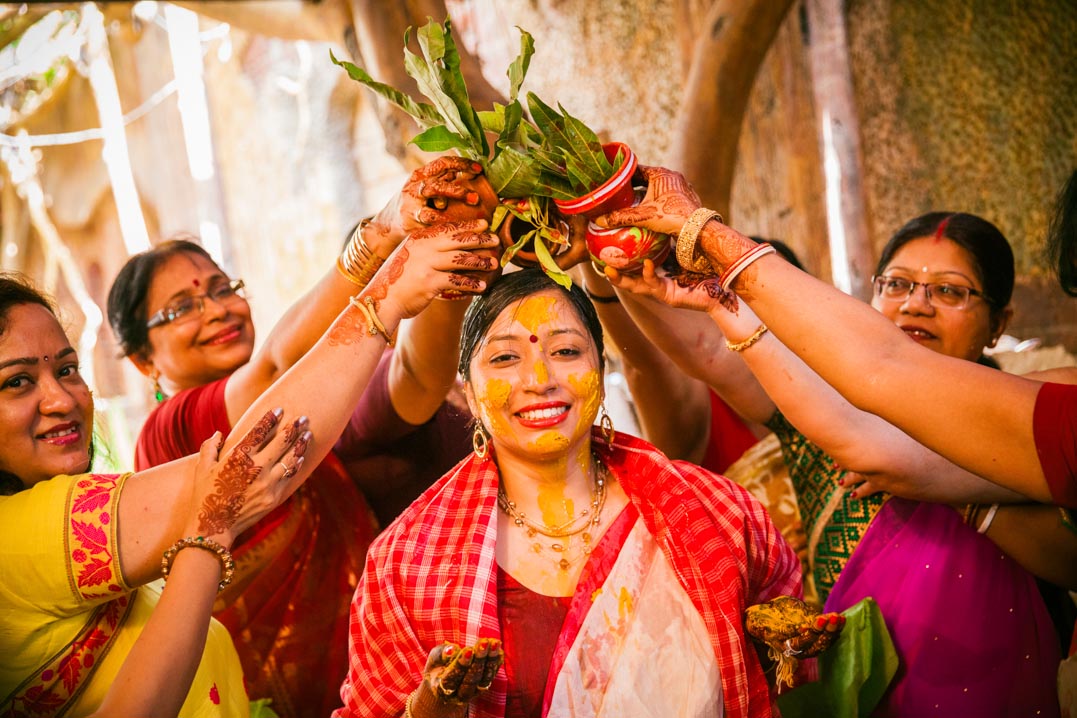The Bengali culture is embroidered with a fine sense of art shining through the elaborate customs rooted in respect, love,and emotion. Exploring the beauty of a Bengali Wedding, we discover the intricacies of traditions and beliefs in its sacred rituals that make life a true celebration.
Bengalis are ardent lovers of arts. They relish their cultural beauty wherever they stay, and they are deeply respectful towards their elders.
A Bengali wedding depicts all this very beautifully. It features many rituals and ceremonies starting from Aashirwaad to BouBhaat and wedding reception. It gives us immense pleasure to take a deep dive into the culture of our audience. We hope you will love this Bengali Wedding journey.
Interestingly, the same rituals have typically two different sets of rules (or ‘niyam’) followed by Bengalis, according to their native roots, depending upon which part of Bengal they hail from. Ghotis (Bengalis native to West Bengal) and Bangals (Bengalis native to erstwhile East Bengal, now Bangladesh after Partition) have distinctly different ways of following the same traditions and this adds more colour, vibrancy, and fun to the wedding rituals. It is a common practice to have marriages where the groom is Ghoti and bride is Bangalor vice-versa and both parties have a lot of fun trying to ensure their sets of ‘niyam’ are followed!
Pre-Wedding Ceremonies
- Aashirwaad (Sagaior engagement)
Bengalis’respect for their elders is exemplary. Aashirwaad, similar to Sagai in North India’s marriages, is a common ceremony observed by the bride’s and groom’s families. It usually takes place much before the wedding. However, Bengalis are flexible in their approach. Keeping the convenience of their guests in mind, they sometimes organise the Aashirwaad just prior to the wedding ceremony.
The objective is to ensure that all the elders in the family, and among friends too, bless the couple. With some dhaan (rice grains) and durba (three pronged grass blade) and sweets, the bride and the groom are blessed. As an expression of blessings, gifts or money are also given. However, unlike the North Indian’ marriages, ring exchange is optional.
- Shree Making
Here comes the test of creativity. This ceremony is performed a day before the wedding at the bride’s home. Before we delve further, it’s interesting to know what Shree means actually. It symbolizes Goddess Lakshmi (Deity of wealth and prosperity).

Shree is made by married women in the bride’s family from rice powder in the baron dala (a tray woven using bamboo fibres which is rounded from one side). The dough of rice is prepared using auspicious materials like turmeric and sindoor (vermilion) and made to stand upright in a pyramidal structure. Mustard oil is also added to gain elasticity. The mixture has to be prepared and kneaded with the correct proportion of the ingredients; otherwise, ittends to collapse. It is then decorated with flowers, designs, colours, and alpana.
- NandiMukh
This ceremony is performed at the bride and the groom’s home by their respective families, a day before the wedding. The significance of Nandi Mukh is to pay tributes to the deceased ancestors of both sides. An elaborate pooja is performed under the guidance of a pundit or some elder member of the family. Holy spirits are invoked to shower their blessings on the bride and groom. After the pooja, a fun factor comes into play. A bachelor lunch billed as the last bachelor lunch for the groom and the bride (known as ‘Aaiboodobhaat’), is organized where friends and family members make the bride and groom eat to their fullest. A special effort is made to cook a number of dishes, including their favourite ones.
- Haldi Ceremony
This is again performed at the home of both families on the wedding day itself. In the morning, the haldi (turmeric paste) is first applied to the groom in a ceremonial ritual by seven married women and then sent to the bride’s home along with the Tattava (collection of gifts), including apparels for the bride and her immediate family, beauty products, footwear, etc. One auspicious gift is fish, packed artistically as part of the gifts. A part of the haldi is applied on the bride also by seven married ladies going round the bride in a merry environment marked by traditional and contemporary songs.
Wedding Ceremony

- Kanyadaan and Saptapadi
The event is arranged by the bride’s family at their residence or a venue, such as a banquet hall or farm house. Two people from the bride’s family, usually an uncle with a brother, go to the groom’s house to pick him up for the ceremony. The groom, along with an uncle or elder brother (Bor Karta) reaches the venue and is greeted at the entrance by women, who welcome him ritually with the baron-daala.
Kanyadaan (giving away of the bride) and Saptpadi (the vows and seven rounds of the sacred fire) are the key rituals that take place in the evening.
Once the marriage ceremony is over, the night (known as ‘baashor’) is spent in fun, games, songs, and merriment with the groom and one of his younger relatives/brother as an escort, spending time with the bride’s siblings and cousins. The rest of the groom’s family and guests leave for home after the ceremony.
In the morning, the bidaai ceremony takes place, i.e., the newly married couple leaves for the groom’s home. This is quite an emotional moment for both the families, particularly for the bride’s one as they part away from their loved daughter or sister.
Post-Wedding Ceremonies

The bride is considered as a harbinger of wealth and prosperity and with her arrival starts the second phase of celebrations at the groom’s home.
- Welcoming the Bride
The bride is welcomed with her feet dipped in a mixture of Alta, Mahawar or Rose Bengal and milk. Alta, a red dye (earlier made from extracts of lac, a plant), is applied all around the edges of the feet of women in all auspicious occasions in Bengali culture. It is symbolic of Lakshmi and Sri. Milk is a symbol of prosperity and health in Indian culture.
Blessings and gold ornaments are offered to the bride. To make the bride comfortable at her new home, usually, some fun activities are organized. One of those is asking her to catch a moving fish in a tray and hold it in her hand. If the bride succeeds in doing so, it’s believed that she would be able to make the groom listen to her!
- BouBhaat (Lunch Ceremony/Reception)
It is now the turn of the bride’s family to bring gifts or Tattava for the bride, the groom, and the groom’s family. A whole fish is an essential part of the gifts apart from dresses, entire bath and beauty kits, footwear, purses, suitcases and wallets, spices, sweets, fruits, curd (yogurt). The objective is to organize all the stuff the newly-wed couple would need to set up their home.
Bengalis who are artistic by nature, try to outdo each other in decorating the gifts. It is not surprising to find the groom’s dhoti folded in the shape of a Ganesh or the bride’s sari resembling a butterfly. Gifts are elaborately showcased in decorated trays and embellished with origami and paper flowers and creatively done name tags for each person whom the gift is meant for. The groom’s family, likewise, sends Tattava decorated ornately, to the bride.
Next day, a boubhaat or lunch is organized at the groom’s home. This is a lucky day for the groom. His fasting that started after Nandi Mukh comes to an end. However, this is a close-family ceremony. A bigger event, i.e., reception, is organized in the evening, which is attended by bride’s family members, extended family of the groom and distant relatives and neighbours.
A Bengali wedding is an occasion for not only for uniting two souls in matrimony but also for two families to enjoy manifesting their multi-faceted creative talents and art acumen in the rituals and decorations of the wedding venue (mandap) and for tattava. Nowadays some people do hire professionals for the decorations but even then, the event is a great fun occasion for both the families, with the women and members of the younger generation leading from the front in organizing all the arrangements.






















